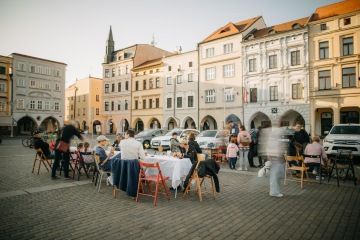Budweis is the European Capital of Culture 2028
In 2028, Budweis and the entire South Bohemian Region will become part of a unique European project that takes place in the Czech Republic only once every thirteen years. Being awarded the title of European Capital of Culture (ECoC) represents an extraordinary opportunity to strengthen the local cultural ecosystem, support artists and organizers, improve the quality of life for residents across generations, and open the city to new visitors from Czechia and abroad.
However, the ECoC is not just a celebration of culture – it is an investment in the future of the city, its cultural policy, infrastructure, creativity and community life. Its benefits will continue far beyond 2028.

The title of European Capital of Culture
The idea of European Capitals of Culture (ECoC) was initiated in 1985 by the Greek Minister of Culture, Melina Mercouri, who presented her vision of cultural cooperation between European countries to the then European Community. Since then, more than sixty European cities have been awarded the title – from large metropolises to smaller towns, which have undergone cultural and economic transformation thanks to the project.
In the Czech Republic, only Prague (2000) and Pilsen (2015) have held the title so far, while other holders include our partner city Linz (2009). Each of these cities confirms that the ECoC brings about the development of cultural institutions, boosts tourism, creates new job opportunities and increases international visibility and prestige.
The title of European Capital of Culture is awarded annually by the European Union to two cities from different member states; every three years, one more city from a non-EU country joins in.
In 2028, Bourges (France) and Skopje (North Macedonia) will join Budweis on the ECoC map.
What does the title bring?
The European Capital of Culture title strengthens the city's position on the European cultural map and brings new impulses in a number of areas: it supports local artists, festivals, creators and independent initiatives; increases visitor numbers and develops tourism services; increases employment in the cultural sector and other areas; and creates projects that encourage the involvement of children, students, families and seniors, brings investment in infrastructure, public spaces and cultural institutions, and opens up new opportunities for international cooperation, partnerships and foreign exchanges. Its greatest value is its long-term positive impact on culture and life in the city.
What will 2028 look like?
The year 2028 will bring an extensive year-round program that will enliven theaters, galleries, and museums, as well as public spaces – from the historic center of Budweis to the city's districts, cultural centers throughout the South Bohemian Region, and the countryside. More than 100 projects and approximately 1,500 events will take place during the year – concerts, exhibitions, performances, workshops, film screenings, discussions and site-specific installations. Artists from all over Europe will come to South Bohemia to present their projects as part of Budweis 2028 program. The program includes over 40 projects that are implemented together with local partners from cultural organizations. You can already encounter many of these projects in Budweis and throughout the region. All current projects can be found in the Projects section.
Education is also a key part of Budweis 2028. We will offer creative education programs for schools, workshops, methodologies and educational materials, accompanying programs for the public – tours, workshops, and discussions – and professional education for cultural institutions and creative industries. The goal is to strengthen skills, curiosity and creativity throughout the region.
(Perma)culture as the basic principle of the Budweis 2028 project
The Budweis 2028 project is not just a program of events. It is a way for the city to work with culture as a tool for development: supporting local creators, strengthening community life, improving conditions for education and opening new opportunities for young people, institutions and businesses. It is based on the principle of (perma)culture – a culture that has a long-term impact and will not lose its meaning after 2028. Just as (perma)culture takes care of the land, we want to nurture the environment in which ideas, encounters and collaborations arise. We are responding to the challenges that European cities face today: the brain drain, the public space challenges, the need for community cohesion and the development of creative industries. We are taking inspiration from local traditions, landscapes, crafts, and stories, and linking them to the European context to strengthen the region's identity and its economic and social resilience. The project supports creativity, solidarity, and belonging, and creates conditions for a culture that is accessible, fair and open. What we are building together towards 2028 should continue to grow – in institutions, communities, public space, and in the way the city thinks about its future. The culture we envision is one that will endure.
At the heart of the project are the people – the residents of the city and the region. They are not just spectators, but co-creators. Everyone can contribute with their voice, energy and story. At the same time, each project considers its long-term impact on the environment, the community and future generations, because without sustainability, there can be no growth. The year 2028 combines local energy with a European dimension, opens the door to cooperation, inspiration and cultural exchange. Europe is a framework that makes our culture more visible, understandable and relevant.
Each year of the project has its own symbolic meaning:
Do you want to become a part of Budweis 2028?
Take a look at the opportunity to get involved in the Get Involved section.
What is currently happening and what events are coming up?
Follow our website - Events and News, our social media, or subscribe to our newsletter!



